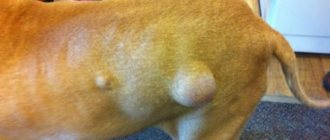How to calm a dog if it is very nervous, afraid or aggressive? The most effective way for her to behave with restraint, not show anxiety, and stop being overly excitable is painstaking training. The owner must always pay attention to her behavior in order to draw conclusions and try to understand the causes of fear or aggression.
How can you tell if an animal is overexcited?
All pets react differently to the same stimuli, so it is quite difficult to name the exact symptoms of overexcitation. Despite this, anxiety always affects behavior. If your pet behaves too strangely and unusually, help him cope with the tension that has arisen.
In most cases, an overexcited state is accompanied by:
- slight trembling;
- tucking the tail and ears;
- uncontrolled urination or bowel movements;
- prolonged barking, howling or whining;
- raised hair on the withers and along the spinal column;
- looking away or dilating the pupils;
- increased sweating of the paw pads.
To relieve tension, it is necessary to eliminate the stimulus or transfer attention to another object. Regardless of the situation, it is very important to remain calm. The owner's equanimity perfectly helps to cope with his own emotions, since four-legged friends trust the authority of the leader of their pack.
Proper walking
Apartment dogs are usually content with a short walk. Yard dogs often don’t go out of the gate at all. Naturally, both will look for ways to escape. Owners must understand that walking should be fulfilling, bring pleasure and help release energy, and not just satisfy physiological needs. Games, practicing commands, exploring a new area, and communicating with brothers will help in this matter. At the same time, the pet must see that the owner is leading him to the place of play, only he releases the dog from the leash and gives the command “Walk!” A tired pet returns to its owner, who treats it with a treat and takes it home for dinner.
How to calm a puppy or dog when they're mad
One of the simplest and most effective ways is affection. Stroking relaxes and soothes, so just run your hand from the top of the head to the hips of your four-legged friend and watch the reaction.
Despite its effectiveness, this method has its own nuances. Affection is the main tool of encouragement. Because of this, your pet may misinterpret your efforts, mistaking them for approval. You should also avoid hugs, which increase anxiety in 85% of cases.
Do not yell or use physical punishment. Both methods are fraught with even greater fear, but in relation to you.
Leave alone
If the reason for the violent behavior lies in hyperactivity or an attempt to attract attention, leave the room and leave the pet alone. Lack of reaction will extinguish interest in further pampering.
Try to ignore the dog until he calms down. Only after this can he be praised, taken for a walk or entertained with a game together. Otherwise, he will perceive all these actions as a reward and will rage on an ongoing basis.
Distract with a toy or treat
If the source of stress or overstimulation cannot be eliminated, turn your attention to your favorite toy or treat. This method will help consolidate pleasant associations. Over time, the dog will feel more confident and calm, even without distractions.
Make noise or splash water
You can distract from an irritant not only with the help of something pleasant. Another irritant produces a similar effect. If the dog gets angry, clap your hands loudly or spray it on his face with a spray bottle. In an attempt to deal with the source of noise or wet fur, the animal will temporarily forget about the main reason for its worries.
Methods for calming down
There are a variety of methods to calm dogs. And the most effective ones have one thing in common - love for their four-legged friend. We must understand his emotions and become his true friend, the leader of the pack. After all, that’s what dogs are for!
Perhaps some variety in games? Change your usual game to a new one and watch the reaction.
This is the most important thing! The pet is mischievous because it wants more attention! Spend more time with your four-legged dog, don't forget that you are friends. Remember that you are the leader of his pack and be the best in his eyes. Rest assured, you will be surprised how quickly the watchdog’s behavior will change.
The familiar world is simply impossible without them; they have been around throughout almost the entire human evolution! Yes, you need to be able to handle them and know exactly how to act in a given situation. But after reading this article we understand that it is not so difficult. Moreover, if everyone were conscientious owners, there would be no problems with dogs at all!
Good luck to you! And don't forget about your pets! After all, we are responsible for those we have tamed.
Source
Helping a dog when scared
Mild fear is an absolutely normal reaction, but pathological cowardice is a serious cause for concern. The appearance of this quality is often the fault of the owners themselves, who are overprotective of their pets.
Constant attempts to hide the animal from unfamiliar guests and covering it with a blanket during thunderclaps interfere with an adequate perception of the world. Instead of total protection, it is necessary to pay attention to proper education and adaptation.
During a thunderstorm or fireworks
The fear of thunder and exploding fireworks is also common among people. The main reason for this phobia is too loud and harsh sound. To suppress it, use soothing classical music. If your pet is often left alone, turn it on all day to reduce possible stress levels.
To get used to frightening sounds, try playing recordings of them regularly, accompanying the unpleasant noise with games or other enjoyable activities. This will help you adapt to the stimulus and reduce anxiety in the future.
If a thunderstorm catches you right on the street, try to find shelter and pet the frightened pet. Sit down next to him so that you are on the same level and reassure him with encouraging words.
New Year's fireworks and firecrackers are the scourge of all dogs who go outside to relieve themselves. Take care of your pet’s comfort in advance and put on an anti-stress vest if there are celebrations going on outside and you still need to go for a walk. This item of clothing puts light pressure on the entire body, reminiscent of a hug. In this outfit the animal feels confident and protected.
When visiting a groomer or veterinarian
Touches from a stranger, painful injections and unpleasant odors can scare off even the bravest pet. Fear of the groomer and veterinarian must be combated with the help of distraction by following commands.
Teach your pet the “down”, “sit” and “give paw” commands. They will help control behavior not only at home, but in unfamiliar places. Once at a haircut or examination, distract the dog by following the command and reward it with a treat or a new toy. This trick will help reinforce a positive association with an unpleasant place. Previously frightening establishments will be perceived as a place to receive a reward for following a command.
On a journey
Traveling in a car over long distances must be taught from childhood. Start by staying together in the cabin without moving, distracting the dog from an unusual place with his favorite toy. Then try driving a short distance with your pet as a passenger. Increase the duration of the trip gradually and do not rush to move into the driver's seat until you are sure of the calmness of your four-legged passenger.
Before your trip, take care of your pet's comfort. Walk him in advance and do not feed him 2 hours before departure. Cover the seat with a soft cushion and take a few toys into the cabin. At the end of the trip, offer a pleasant reward - this could be a walk in the park or in the forest, where you can run without a leash.
Under severe stress
Pets often experience stress during noisy gatherings in a large company, moving, changing owners, having a child or a new pet. In such situations, the following recommendations will help:
- Respect personal space. Every pet should have its own secluded corner where it can hide from annoying guests. Ask your friends not to bother the dog or force him into unwanted communication. Over time, he will get used to the smell and sight of frightening strangers and will try to establish contact with them on his own.
- Give your four-legged friend to your friends for foster care in the first days of moving. Moving things, repairing and cleaning in a new place are the most alarming events that should be avoided. Settle down in the house, arrange a sleeping place for your pet and be sure to transport his personal belongings, which have retained their usual smell. Only after this can the dog be introduced to an unusual environment.
- Be patient and kind. If you got the animal from other owners, avoid pity. When communicating, use only positive emotions to win the trust and love of the new family member.
- Avoid changing established relationships. If you have a baby or have another dog, try to pay equal attention to each family member. Avoid excessive displays of love for the “new recruit” in front of the “old man.”
In addition to fear, excessive excitability can be explained by a hormonal surge. Most often, owners of uncastrated males and females encounter this problem.
What not to do
You cannot shout commands “Silence!” or “Ew” to stop barking. This will get you nowhere. On the contrary, such actions can provoke your pet even more. He will see that they finally paid attention to him. And for him this is more valuable than being scolded.
Do not beat the animal or put a shock collar on it. This can lead to negative results - the dog will turn into an aggressive neurasthenic who will even hate his owner.
You cannot praise or stroke an animal, saying “well done” if it barks and tries to protect you from strangers. This way you can train him to attack all strangers.
If hormones are playing
In addition to sexual hunting, childbirth and pregnancy affect the emotional state. In the second case, hormones can go crazy even during false pregnancy, so sterilized animals are not immune to mood swings.
During estrus in a bitch or heat in a dog
The most effective and safest way to solve the problem is castration. This operation stops the production of sex hormones and stabilizes the emotional state.
When participating in breeding, use sedatives. Before use, be sure to consult a veterinarian, as hormonal drugs have a long list of side effects.
During pregnancy and childbirth
A pregnant pet is very sensitive, so try not to leave her alone for a long time. Make sure the puppy nest is located in a cozy and quiet area. This will prevent the expectant mother from worrying due to extraneous noise.
During childbirth, try to be nearby. This will give the woman in labor confidence and a feeling of security.
During a false pregnancy
False pregnancy is accompanied by increased anxiety, as a pet prepared for the birth of puppies is faced with their sudden absence. Instead of babies, she begins to babysit toys, dragging them into the “nest”.
This condition lasts no more than 2 weeks, so just be patient and play along. Don't take away toys or yell at your pet for her quirks.
If false pregnancy occurs regularly, be sure to sign up for sterilization. Otherwise, mastitis or other dangerous complications may develop.
We choose a sedative according to the size of the breed: for small, medium and large dogs
When choosing a sedative, you should also pay attention to the pet’s weight and the instructions for the drug so that an overdose does not occur. Choosing the right volume and mg quantity can save time and money.
| Name/form of release | For small ones | For average | For large |
| Suspension Pchelodar Vetspokoin | 25 ml | 75 ml | 75 ml |
| Stop stress drops | 10-15 ml | 30 ml | 50 ml |
| Stop stress pills | 200 mg | 500 mg | 500 mg |
| Zilken capsules | 75 mg up to 10 kg | 225 mg 10-30 kg | 450 mg 15-60 kg |
What to do with an aggressive dog?
First of all, analyze the situation to understand exactly how to calm an aggressive dog. Unlike a strange dog, a beloved pet is unlikely to attack you without warning. This will give you time to think.
Redirected aggression can be explained by fear. In this situation, act according to the circumstances, focusing on the previously proposed advice.
If the reason for inappropriate behavior lies in childish restlessness, insufficient upbringing or lack of activity, work on these issues. Don't let your puppy play with your hands or lunge at people. To wean him off, use prohibition commands and non-traumatic punishments (slapping a newspaper on the floor, spraying water from a spray bottle, ignoring). Timely training and regular walks accompanied by active games will help improve obedience and eliminate hyperactivity.
Features of breeds
The principles of such behavior may also depend on the breed. Each species has its own characteristics of behavior and character, which affects the predisposition to bite:
| Breed of dog | Breed Features |
| Alabai | Central Asian Shepherd, which has a calm and balanced character. It can only show aggression towards strangers, protecting its territory. Alabai is easy to train, so the pet will not just gnaw or bite. |
| York | A miniature breed that has the habits of large dogs. These are very curious, playful and loyal pets. But if you don’t start training on time, behavior problems may arise. |
| Laika | These are professional hunters who are also used for riding. Laikas are very loyal and kind, they love communication. They can become wonderful guards and protectors. But if you pay little attention to them, then problems with discipline on the part of the pet may begin. |
| Dachshund | A professional hunting dog that is constantly on the move, very curious and active. Due to this nature, problems may arise that include damage to furniture, clothing and bites on the body. |
| Spitz | This is a decorative breed that has a lot of features. Spitz are curious and active. But if you don’t give them time to play, your pet’s character may deteriorate. He will become aggressive and start doing dirty tricks, including chewing on everything. |
| German Shepherd | The most popular and widespread breed. These are wonderful guards and friends for humans. They need regular walks over long distances. At an early age, the pet can chew shoes and furniture, and also bite the owner during games. |
On a note! Hunting breeds are most predisposed to gnawing and biting, as this is their basic instinct, laid down at the genetic level.
What to do if your pet barks, howls or whines?
Voice signals always have a reason, so to correct unwanted behavior you need to find them. Make sure you give your pet enough time.
Avoid boredom while leaving for work. Interactive toys and channels or YouTube videos filmed specifically for pets will help you cope with longing for your owner.
Work through situations with the main irritants, reinforcing positive associations. In 95% of cases, it is possible to wean a dog from barking without outside help. If all the proposed methods of struggle do not produce results, contact a dog handler.
Don't forget that sometimes inappropriate behavior can be explained by pain caused by an illness. Make sure your four-legged friend is healthy before enrolling in a training course.
Additional questions
What is a Calming Diffuser for Dogs?
A calming diffuser for dogs is a special electronic device that diffuses a pheromone that calms the dog. It works like a fumigator or air freshener.
What medications can calm a dog?
You can use medications such as VetSpokoin, Stop-stress, Beaphar NO STRESS, Valerian or peppermint. But there is no need to self-medicate. All medications must be prescribed exclusively by a veterinarian.
Soothing drops
Drops can be added to food or directly dripped into the mouth. You can also dilute it with water and drink it from a syringe without a needle.
However, some owners note increased drooling in dogs and a reluctance to take drops . In this case, you should choose a different form of release of the drug.
| Name | Principle of operation | Price, rub |
| Calming drops “ Relaxivet ” for dogs, 10 ml | The result is noticeable within an hour and lasts for about 5-6 hours. The base is herbs. Ideal option for travel. | 170-209 |
| Cat Bayun VEDA Infusion for the correction of behavioral disorders in dogs, 10 ml, 3 bottles | Cumulative calming effect of herbs. Convenient release form. | 170-200 |
| Pchelodar Vetspokoin suspension , for small dogs, 25 ml | Contains phenibut, promazine, herbs and royal jelly. Has a tranquilizing and relaxing effect. | 200-500 |
| Stop Stress Plus drops for dogs, fl. 50 ml | It is based on natural amino acids and has the smell of milk chocolate. Dogs happily take the drops. | 200-250 |
| Drops for dogs Fitex fl. 10 ml | Water-glycerin-based herbs have a gentle effect on the body without causing adverse reactions. | 150 |











